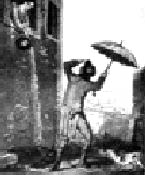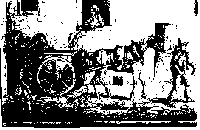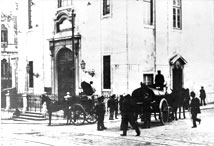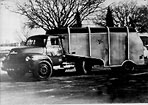| Here goes the water ...Brief History
of Urban Cleaning
 Fortunately, chronic water shortages in the city are
a thing of the past. Fortunately, chronic water shortages in the city are
a thing of the past.
However, that does not mean
that in times gone by, said shortages prevented the people of Lisbon from throwing water
out the window together with the cry "here goes the water" whenever they wanted
to be rid of a bucketful of smelly water.
Far back in 1300 and 1400,
despite repeated royal stipulations directed to the Senate, the latter was unable to solve
the problem of dirty streets, in a city with no drains and uneven pavements.
Only in 1496 did D. João III stipulate
that there be men paid by the residents to "clean the city" in the different
parishes. However, in 1522 there were only four men carrying out said task.
 Up until 1607
there were no significant changes in this situation. On this date it was stipulated that
the cleaning services were to be carried out by the company "real da carne", and
that carts and rubble carriers were to be used in all the neighbourhoods. This because the
amount from the residents' contributions was not enough to pay for the cleaning task. Up until 1607
there were no significant changes in this situation. On this date it was stipulated that
the cleaning services were to be carried out by the company "real da carne", and
that carts and rubble carriers were to be used in all the neighbourhoods. This because the
amount from the residents' contributions was not enough to pay for the cleaning task.
Years later, it was decided
that the cleaning be done at the cost of the city's public finances, and the waste taken
to the river before dawn.
The city looked a little
better in the 18th Century, thanks to two decrees (1738 and 1746) which stipulated that
".... no resident shall throw water or wastes into the streets, or have these thrown,
neither during the days, nor at night, except after the bell has rung ..."
However, foreign visitors
of the era did not recognise this improvement, and in "Description de la Ville de
Lisbonne", published in 1730, one can read:
"At night, there are no lights in this
great city, and thus one often gets lost, running the risk of being soiled by the filth
usually thrown out the window, as these houses do not have latrines. The general
obligation is to take this filth to the river ... but this order is not strictly obeyed,
especially by the people..."
 At the beginning
of the 19th Century, Lisbon was still a dirty city, disorganised and smelly. It enchanted
people with its beauty and picturesque, but disappointed them with its chaotic streets and
the backwardness in which the people lived. The narrow and torturous roads leading to the
popular neighbourhoods were scattered with all types of debris, creating veritable dumping
grounds. They were also full of holes and dirty puddles of water where tattered children
splashed about... (in exhibition "O Povo de Lisboa" (The People of Lisbon),
1979). At the beginning
of the 19th Century, Lisbon was still a dirty city, disorganised and smelly. It enchanted
people with its beauty and picturesque, but disappointed them with its chaotic streets and
the backwardness in which the people lived. The narrow and torturous roads leading to the
popular neighbourhoods were scattered with all types of debris, creating veritable dumping
grounds. They were also full of holes and dirty puddles of water where tattered children
splashed about... (in exhibition "O Povo de Lisboa" (The People of Lisbon),
1979).
Organising
the city's cleaning services was attributed to the Lisbon City Council in this century, by
creating a group of workers with stipulated salaries and paid by the city council's
services. Later, cleaning the city was bought at an auction by a person who privately
contracted various people to carry out said cleaning, under the orders of the auction.
At the beginning of the 20th Century, the City Council was once more in
charge of organising the city cleaning services, incorporating the people carrying out
this task.
The use of metal bins for
wastes was only adopted in 1951.
The bins had to be numbered and registered
with the City Council and identical to the model approved by the municipality.
 By the
end of the 1950's, there were approximately 1,430 public workers cleaning the city. By the
end of the 1950's, there were approximately 1,430 public workers cleaning the city.
At the same time, the first garbage removal
vehicles appear, equipped with compressing equipment, and thus ending the era of animal
drawn vehicles.
 The hermetic removal system was introduced in 1979, accompanied
by a strong awareness campaign for the residents to comply with the correct norms for
disposing of their waste so as to make Lisbon a clean city. The hermetic removal system was introduced in 1979, accompanied
by a strong awareness campaign for the residents to comply with the correct norms for
disposing of their waste so as to make Lisbon a clean city.
Over the
last five years, the hermetic removal system introduced in 1979 has been significantly
restructured. New mechanical small and medium capacity means have been introduced which
operate throughout the city, and cleaning posts and sub-posts have been restored and
modernised, thus dignifying the working conditions in this fundamental area of city
activity. Furthermore, the containers distributed among the population and the vehicle
removal systems have been replaced, ensuring greater ease and safety in operating the
system.
 Over this period, selective removal subsystems have also
increased for some materials present in Lisbon's waste. The selective glass removal system
has been studied and developed, the new selective paper and cardboard removal system has
been introduced, and the separation of iron-containing metals has increased in the solid
waste treatment station at the Solid Waste Treatment Central - situated in Beirolas. Over this period, selective removal subsystems have also
increased for some materials present in Lisbon's waste. The selective glass removal system
has been studied and developed, the new selective paper and cardboard removal system has
been introduced, and the separation of iron-containing metals has increased in the solid
waste treatment station at the Solid Waste Treatment Central - situated in Beirolas.
Following the Expo98 project and the need
to clear the lands where the Solid Waste Treatment Central had been implemented, VALORSUL
was created. Since mid 1998, this company has ensured the treatment and final
destination of solid urban wastes in the municipalities of Lisbon, Loures, Amadora and
Vila Franca de Xira. |

